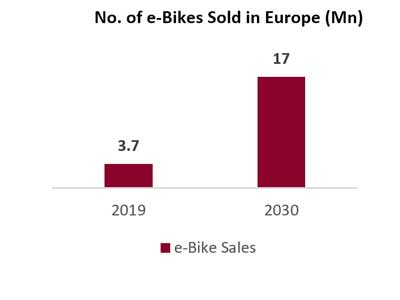
11 Dec Micromobility: Outlook in a Post-Covid World
The ever-rising congestion in cities is causing all existing modes of transportation – both public and private – to almost burst at their seams with dire economic fallouts. The systemic inability to keep pace with the world’s growing urban population’s demand, coupled with a coordinated focus on climate change, has led the demand for environment friendly options to soar in recent years. To top it all, the Covid-19 pandemic has given a strong fillip to the demand for ‘green’, single-rider, open-air transit alternatives – and micromobility seems to tick all the boxes.
In 2019, Americans lost an average of 99 hours per year due to traffic congestion, costing the country nearly $88 Bn.
Robust post-pandemic recovery and the consequent shift in user preferences is giving a shot in the arm to the micromobility market (trips typically shorter than 5 miles). The impressions of this growth are already visible – Europe’s proposed ban on production of gasoline and diesel vehicles will directly boost the shift to alternate modes, while in North America, in 2020, nearly 224 cities across US, Canada and Mexico already had at least one public bikeshare or e-scooter system.


Several other factors that accentuate the demand and uptake of micromobility solutions:
- Urbanization – additional 2.5 Bn people projected to reside in urban areas by 2050, leading to majority of trips to fall within the category of micromobility
- Funding – micromobility startups received $14 Bn in equity funding worldwide since 2017
Countries, cities, and governments are also throwing their weight behind making micromobility more accessible and viable:
- UK: Committed $300 Mn fund to construct new bike lanes and wider pavements
- Milan: Transforming 35 km of streets used by cars for walking and cycling
- Seattle: permanently closed 30 km of streets to most vehicles in 2020
- Paris: Planning to invest $325 Mn to update its bicycle network
- Brussels: Turning 40 kilometers of car lanes into cycle paths
- Montreal: Planning to create more than 320 km of new pedestrian and bicycle paths
The trend, however, does not confine itself to Europe and America. China, which pioneered a dockless bike-sharing platform in 2015, witnessed exponential growth of micromobility startups in the last 5-7 years. However, lack of regulations oversaturated the market, creating an oversupply of bicycles in cities and China’s infamous bike dumping grounds. The market still holds tremendous potential and players such as Meituan Bike and Hellobike are prominent players. The Indian market is also slowly adopting the micromobility theme, with some bike sharing platforms operating close to railway and metro stations in cities like Delhi, Chennai, Mumbai, etc.
Indian players have already requested the government to grant a 20% Production-Linked Incentive (PLI) for five years to the bicycle and e-cycle segment.
The buzz has kept the tech companies engaged, through introduction of electric bikes and scooters across hire and share schemes globally, which has also attracted Venture Capitalists. Governments and the private sector are keen to make e-bikes more universal.


In addition to these testaments to the tech shift in micromobility:
- US’ proposed e-Bicycle Incentive Kickstart for the Environment (E-BIKE) Act, offers a 30% tax credit on e-bikes
- Increasing use of Telematics to gather user behaviour data from e-bike fleets that can then be subject to advanced analytics and help improve services, user experience, and operational efficiency
However, micromobility still has a long way to go before it witnesses a homogenous and worldwide adoption. Countries and governments will need to commit to develop adequate infrastructure (docking stations, bike lanes, anti-theft systems, etc.) as much as citizens will need to play their part in helping maintain them. Unless wrapped within a solid and secure regulatory framework – covering users, manufacturers, and service providers – the micromobility segment may continue to languish in most parts of the developing world, impeding an all-round adoption.
Although micromobility is built on the premise of being environmentally sustainable, regulations and innovation will need to address the issue of recycling as well – what happens to discarded bikes and scooters? Unless there are proven methods to ‘recycle and reuse’, old and discarded vehicles might become a ubiquitous sight and pose a threat to the very environment they seek to protect.


No Comments